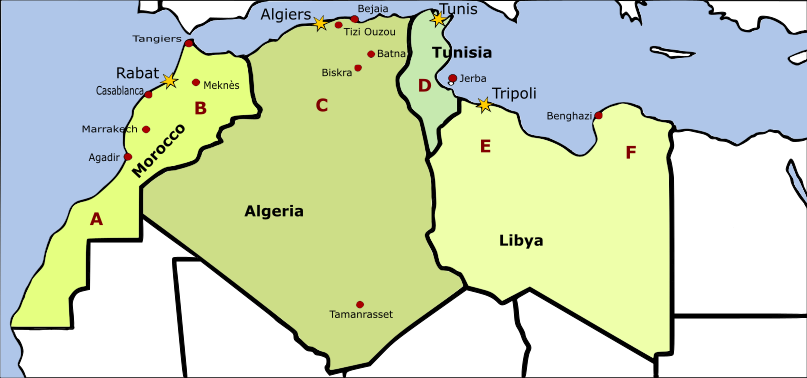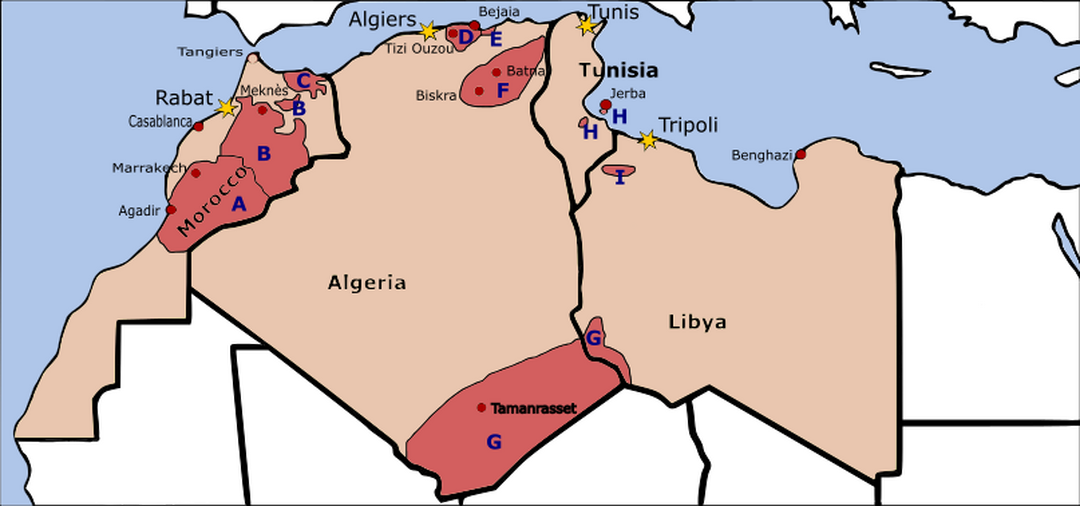Arabic Languages of Morocco
The Arabic language is spoken throughout the Middle East and across North Africa, but the variety of Arabic spoken differs from one country to the next, and even from one region to another within the same country. Besides Modern Standard Arabic, there are two Arabic languages spoken in Morocco: Moroccan Arabic in the north, and Hassaniya in the south. Worldwide there are over 24 major Arabic dialects.
Language map (Arabic)

| A - Hassaniya | B - Moroccan Arabic | C - Algerian Arabic |
| D - Tunisian Arabic | E - Western Libyan Arabic | F - Eastern Libyan Arabic |
|
Modern Standard Arabic is the language of education and the media. |
|
Moroccan Arabic, also known as Darija, is spoken by the majority of the inhabitants of Morocco, either as a first language or as a second language in addition to one of the Berber languages. It is very different from Arabic as used in the Middle East and sometimes cannot be understood well by Arabic speakers from outside of North Africa. The New Testament in Moroccan Arabic is available at the Asdika website (https://www.asdika.org/mab/matt/ ), along with Moroccan Arabic worship music, testimonies in video and audio form, and an active discussion forum. Scripture portions may be accessed online or may be downloaded for offline use. On Google Play store an app for mobile phones containing the Moroccan Arabic New Testament in text and audio form is available. The Jesus Film and Magdalena, a film about the story of Jesus as seen through the eyes of Mary Magdalene, are available in Moroccan Arabic at jesusfilm.org/search.html?q=moroccan+arabic. A series of Biblical stories in Moroccan Arabic is available for listening and downloading at the website of the OneStory Partnership. These stories provide a condensed, chronological presentation of the redemption story drawn from Scripture. The Gospel Recordings website hosts additional Scripture materials in Moroccan Arabic. |
|
Hassaniya is the variety of Arabic originally spoken by the Beni Ḥassān Bedouin tribes, who extended their authority over most of Mauritania and the western Sahara between the 15th and 17th centuries. Hassaniya is relatively distant from other North African varieties of Arabic. Today, Hassaniya is spoken in Algeria, Libya, Morocco, Mauritania, Mali, Niger and Senegal. The audio version of the New Testament in Hassaniya Arabic is available at kutubhassaniya.org. Scripture portions may be played online or downloaded for offline use. The Jesus Film is available in Hassaniya Arabic at jesusfilm.org/search.html?q=Arabic,%20Hassaniya. The Gospel Recordings website hosts additional Scripture materials in Hassaniya Arabic. |
Berber Languages of Morocco
Language map (Berber)

| A - Tachelhit | B - Tamazight | C - Riffi Tamazight (Tarifit) |
| D - Kabyle | E - Tasahlit | F - Chaoui |
| G - Touareg | H - East Zenati | I - Nafusi |
|
Tachelhit - Of the Berber languages of Morocco, Tachelhit has the greatest number of speakers. It is spoken mainly in the south-central part of the country in an area bounded by the High Atlas mountain range to the north, the Atlantic coast on the west and the Algerian border on the east. Principal cities where Tachelhit is spoken include Agadir and Marrakech. |
|
Riffi Tamazight (Tarifit) is spoken in northwest Morocco. It is one of the many Berber languages of North Africa. There are around 1.5 to 2 million mother-tongue speakers of Riffi in Morocco and in European countries such as Spain, France, Belgium, the Netherlands and Germany. There are two main web sites where Riffi materials can be found. |
|
Tamazight of the middle/central Atlas is spoken in the central part of Morocco. The main towns are Meknès, Azrou, Khenifra, Béni Mellal, Azilal, Imilchil, Tinghir, Rissani, Midelt, Talsinnt, Tazaa, Sefrou…). It is one of the many Berber languages of North Africa. There is not a specific name for this language, since all Berber languages are called Tamazight. It is often easier to identify speakers of this Tamazight by asking them if they are Riffi or Tachelhit speakers. If they deny, they are most likely speakers of Middle Atlas Berber. There are around 3 to 4 million mother-tongue speakers of this language in Morocco and in European countries such as Spain, France, Italy and Germany. There is a main web site (tamazight.info/) where materials can be found in audio, video and text formats. In addition to Biblical materials this site also hosts many Scripture-based stories, music, radio messages, historical documentaries, and a free download page. |
|
Other Berber Languages of Morocco: There are several smaller Berber languages spoken in Morocco, but as yet there are no known Biblical materials available in them. These languages include Ghomara and Senhaja in the north, and the Berber of Figuig in the east. |
Next: Languages of Algeria